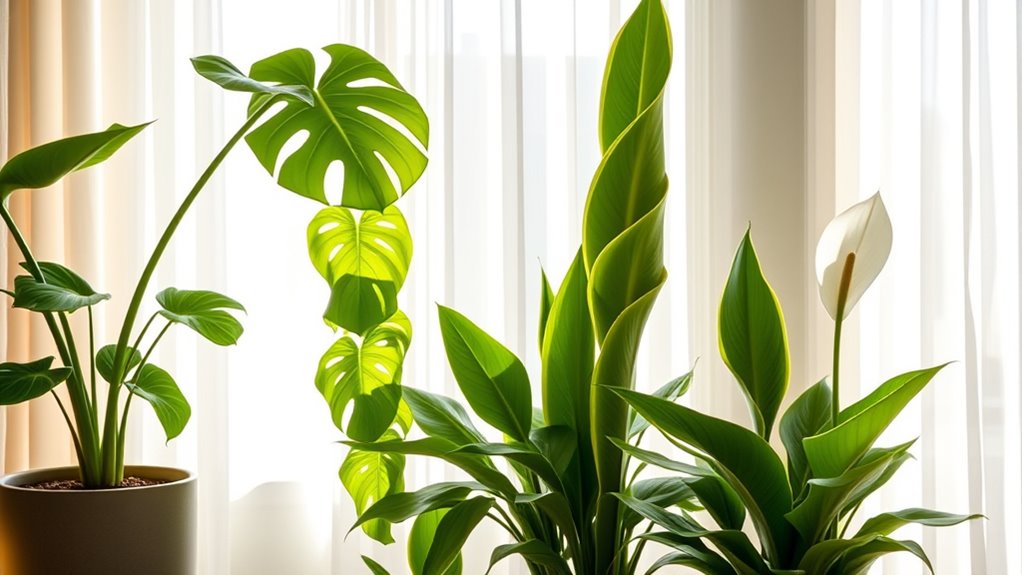To improve air quality and aesthetics in your home, consider adding plants like Spider Plants, Peace Lilies, Snake Plants, and Boston Ferns. These indoor plants don’t just filter pollutants like formaldehyde and benzene; they also enhance your decor with their natural beauty. They’re easy to care for, thrive in various light conditions, and offer health benefits, too. Stick around to discover more tips on choosing the perfect plants for your space.
Key Takeaways
- Spider Plants and Peace Lilies effectively remove pollutants like formaldehyde, enhancing air quality while adding aesthetic appeal to any space.
- Snake Plants and Golden Pothos thrive in low light, making them perfect for darker rooms while purifying the air.
- Boston Ferns excel at filtering volatile organic compounds but require high humidity, adding a lush look to your indoor environment.
- Incorporating a variety of plants increases air purification effectiveness and enhances the overall visual appeal of your home or office.
- Combining plants with air purifiers maximizes both air quality and aesthetic benefits, creating a healthier and more beautiful indoor atmosphere.
Top Air-Purifying Plants for Your Home
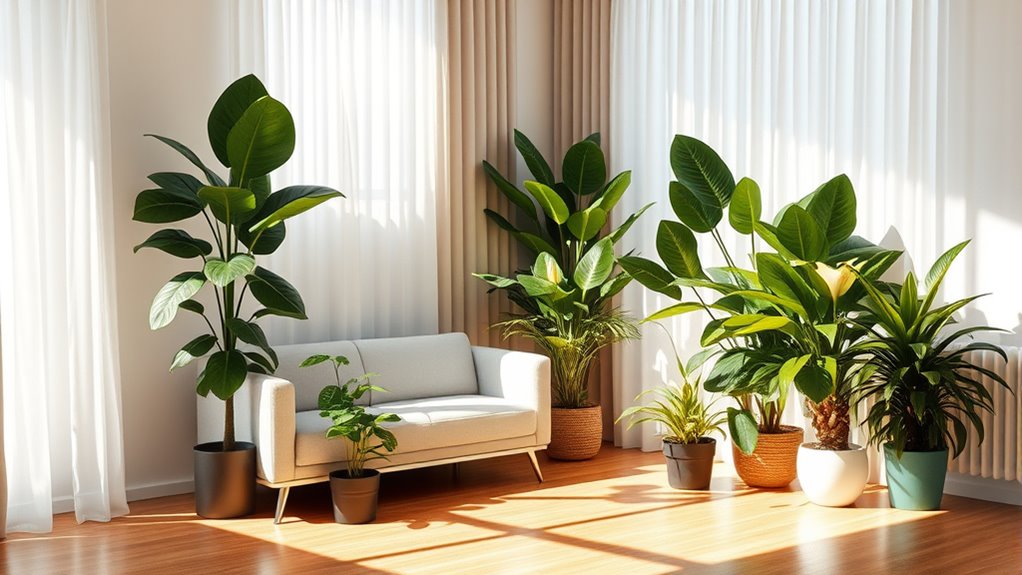
When you want to improve your home’s air quality, consider adding some top air-purifying plants that not only cleanse the air but also enhance your living space.
The Spider Plant and Peace Lily are great choices for removing formaldehyde and other indoor pollutants.
If you’re looking for low-maintenance options, the Snake Plant and Golden Pothos thrive in low light while effectively filtering toxins.
Boston Ferns, though requiring more humidity, excel at removing volatile organic compounds.
By incorporating these air-purifying plants, you’ll not only tackle indoor air pollution but also create a vibrant atmosphere.
Each plant has unique qualities that contribute to a healthier home, making it easier for you to breathe easier and enjoy your surroundings. Additionally, you can enhance the ambiance of your space with essential oils that promote relaxation and improve overall well-being.
Benefits of Indoor Plants for Air Quality
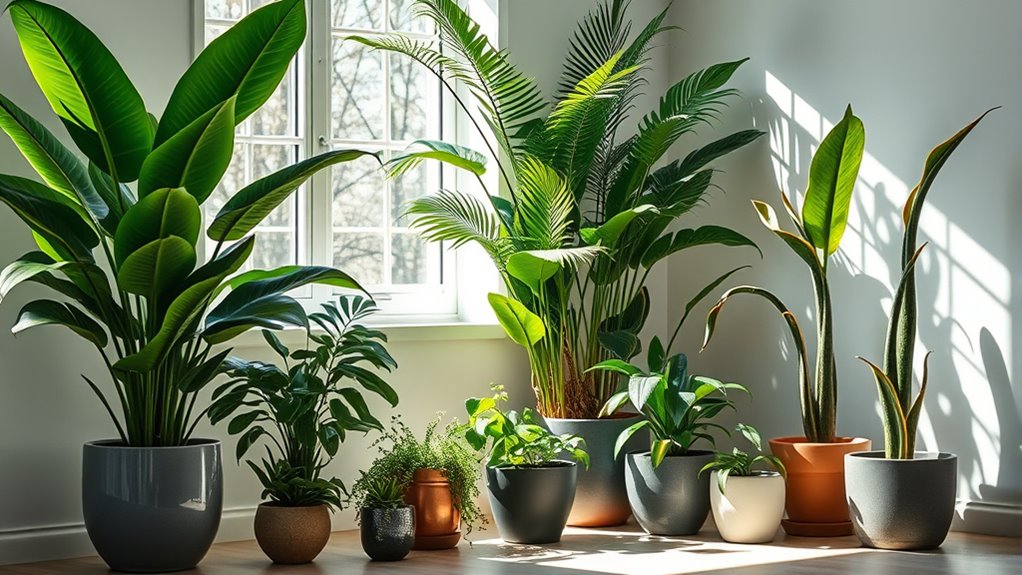
Indoor plants offer numerous benefits for air quality, making them a valuable addition to any home.
They’re effective at removing pollutants like formaldehyde, benzene, and xylene, as shown in NASA’s Clean Air Study. For instance, a single spider plant can purify the air in a 200-square-foot room by absorbing toxins such as carbon monoxide.
Additionally, indoor plants improve air quality by absorbing carbon dioxide through photosynthesis while releasing oxygen, creating a fresher atmosphere.
They also contribute to increased humidity levels, which can alleviate respiratory issues and dry skin. Furthermore, certain plants can enhance color accuracy in indoor environments, creating a more visually appealing space.
Care Tips for Maintaining Healthy Houseplants
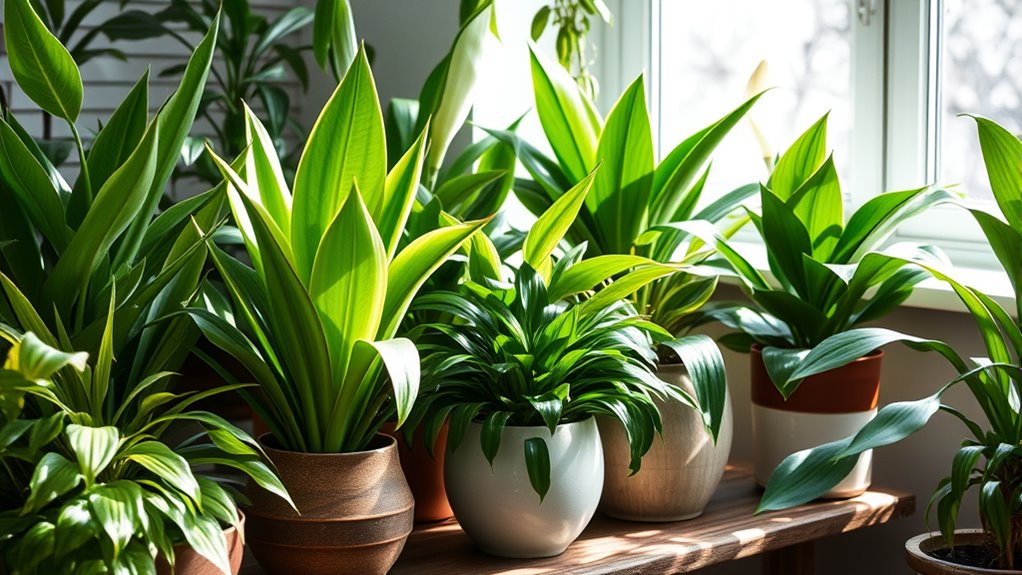
To keep your houseplants thriving and beneficial for air quality, it is vital to understand their specific care needs. Regularly clean leaves with a damp cloth to remove dust and enhance air purification. Verify each plant gets the right light; rubber plants love filtered sunlight, while snake plants thrive in low light. Monitor soil moisture; overwatering can cause root rot, especially in humidity-loving plants like Boston ferns. Fertilize during the growing season to provide essential nutrients, but avoid over-fertilization. For plants like peace lilies, misting helps maintain humidity for peak growth. Additionally, ensure that your pots have drainage holes to prevent waterlogging, which is crucial for plant health.
| Care Aspect | Tips | Importance |
|---|---|---|
| Light | Match to plant needs | Promotes healthy growth |
| Water | Avoid overwatering | Prevents root rot |
| Clean Leaves | Wipe for better air quality | Enhances purification |
Comparing Plants and Air Purifiers
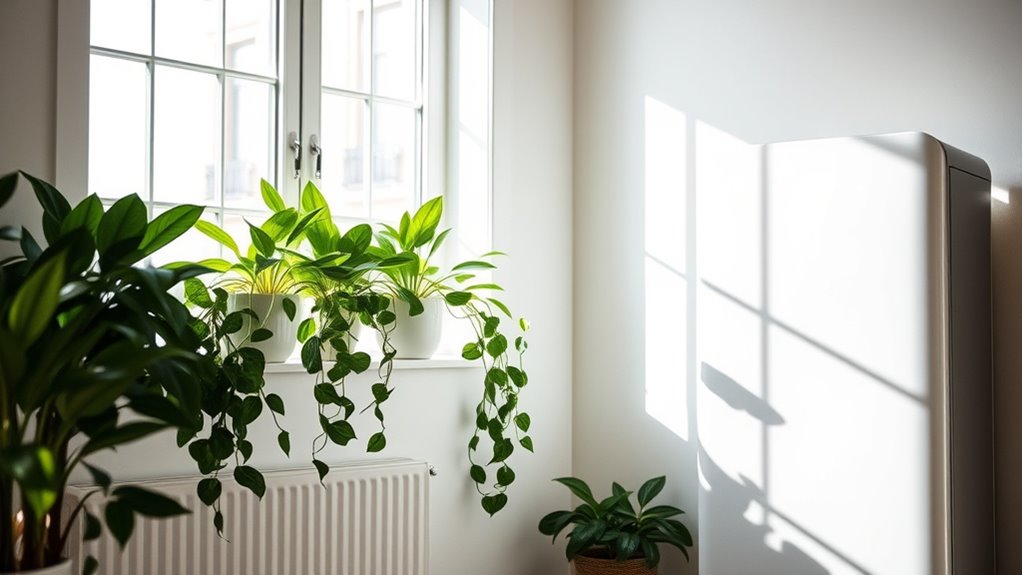
While both plants and air purifiers play essential roles in improving indoor air quality, they function in distinctly different ways.
Plants provide natural air purification by absorbing harmful pollutants like formaldehyde, making them some of the best air purifying plants. However, their effectiveness is generally slower, often requiring a larger number to remove a wide range of air pollutants.
Plants naturally purify the air by absorbing harmful pollutants, though their effects take time and often require many to be effective.
In contrast, air purifiers offer immediate impacts and are particularly effective at filtering particulates through an air filter, but they can require energy and regular maintenance. Additionally, HEPA filters are known to capture 99.97% of particles as small as 0.3 microns, making them a powerful choice for improving air quality.
Combining plants and air purifiers creates an ideal environment, maximizing aesthetic benefits and long-term environmental benefits. Plus, plants are low-maintenance, offering ongoing beauty without additional operational costs to enhance your space.
How to Choose the Right Plants for Your Space
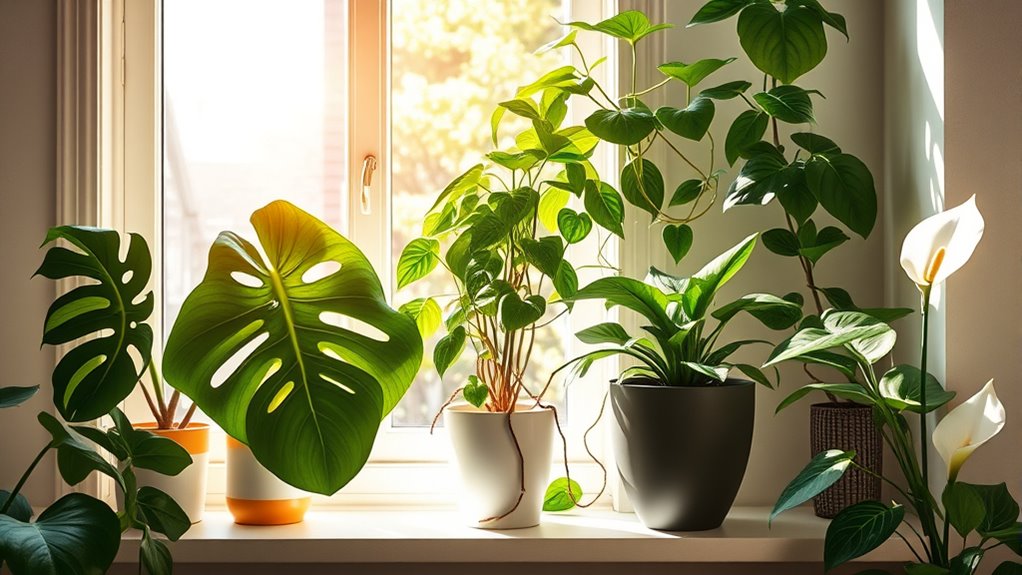
When choosing the right plants for your space, start by evaluating the light conditions; some plants thrive in low light, while others need bright exposure.
Next, think about how much maintenance you can handle—low-maintenance options like Golden Pothos are great for busy lifestyles.
Assess Light Conditions
Understanding the light conditions in your space is essential for selecting the right indoor plants. Start by evaluating how many hours of direct or indirect sunlight each area receives. This knowledge helps you make informed plant choices.
Here are some tips to guide you:
- Low Light: Choose Snake Plants and Pothos for darker areas that thrive in minimal sunlight.
- Bright Indirect Light: Consider Peace Lilies and Rubber Plants, which flourish with filtered sunlight.
- Direct Sunlight: Opt for sun-loving plants like Aloe Vera and Spider Plants, needing bright light for health.
- Humidity Levels: Keep in mind that humidity affects plant choices; for example, Boston Ferns love high humidity, while succulents prefer drier conditions.
Consider Plant Maintenance
Choosing the right indoor plants goes beyond just matching them to light conditions; you also need to contemplate how much time and effort you’re willing to invest in their care.
Some plants, like spider plants and peace lilies, require minimal maintenance, making them ideal for busy lifestyles. In contrast, Boston ferns and bamboo palms demand more attention, such as regular misting and humidity checks.
Consider your space—larger plants like weeping figs can be stunning focal points, while smaller options like English ivy are perfect for hanging arrangements.
If you have pets or kids, opt for non-toxic varieties to guarantee safety.
Finally, establish a consistent watering schedule to maintain peak air quality and plant health.
Enhancing Aesthetics With Indoor Greenery
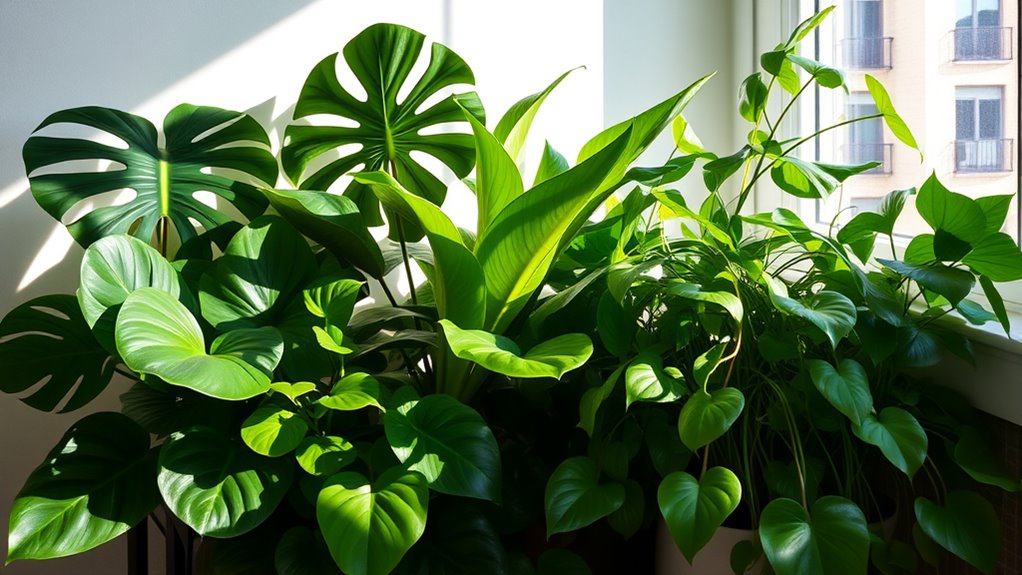
Incorporating indoor plants into your space not only enhances air quality but also elevates the aesthetic appeal of your environment.
Enhance your space’s air quality and aesthetic appeal with the vibrant addition of indoor plants.
Here are four ways to enhance aesthetics with indoor greenery:
- Choose Air Purifying Plants: Select varieties like the Peace Lily and Spider Plant that filter toxins and add vibrant greenery.
- Add Colorful Blooms: Incorporate flowering plants like Gerbera Daisies to create an inviting atmosphere and boost visual appeal.
- Use Stylish Decorative Elements: Boston Ferns and Rubber Plants serve as chic accents while improving air quality.
- Create Vertical Landscapes: Utilize hanging planters with trailing plants like Golden Pothos to maximize space and add depth to your decor.
These strategies will transform your home into a stylish haven filled with life.
Ongoing Research on Plants and Air Quality
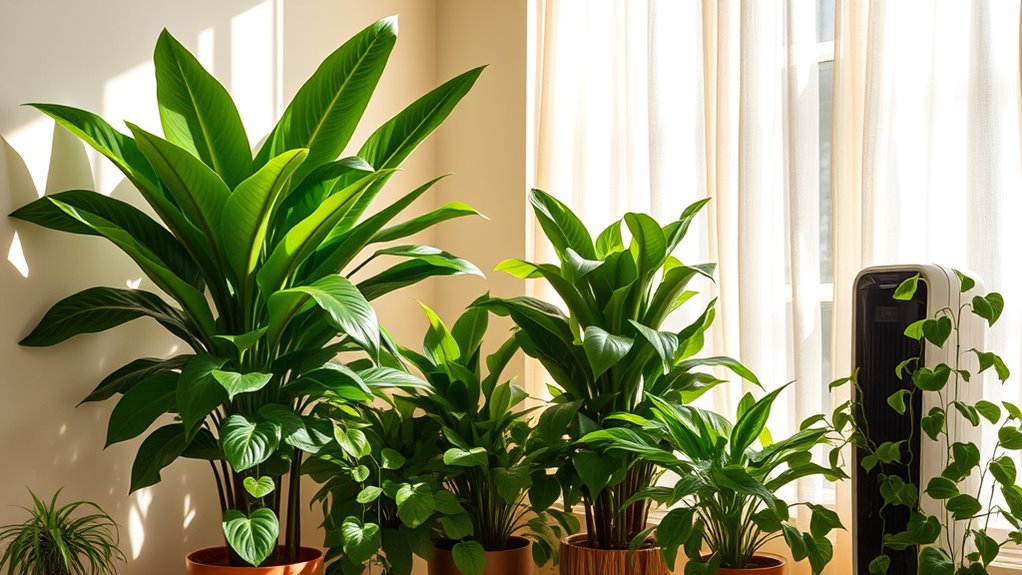
As researchers dive deeper into the relationship between plants and air quality, they’ve uncovered fascinating insights that could transform indoor environments.
NASA’s Clean Air Study identified specific plants capable of removing air pollutants like benzene and formaldehyde, proving essential for clean indoor air.
Ongoing research is exploring how different species filter these pollutants more effectively, with soil microorganisms playing a critical role in purifying the air.
Studies suggest that increasing the number of plants enhances their purification efficiency, highlighting the importance of plant density for ideal air quality.
Additionally, researchers are investigating plants’ potential for life support systems in space, emphasizing their ability to remove carbon and sustain air quality, ultimately benefiting both occupants and the plants themselves. Furthermore, incorporating energy efficiency practices in indoor environments can enhance overall air quality by reducing reliance on energy-consuming systems that may contribute to indoor pollution.
Frequently Asked Questions
Which Indoor Plant Purifies the Air the Most?
When you’re looking for an indoor plant that purifies the air the most, consider the Spider Plant or the Peace Lily. Both excel at removing harmful pollutants.
The Snake Plant is also a great choice, as it thrives on neglect while still filtering toxins. If you want something that needs a bit more care, the Boston Fern can be effective too.
Choose the one that fits your lifestyle and enjoy cleaner air!
What Plant Removes 78% of Airborne Mold?
Imagine coming home after a long day, only to sneeze from all the dust in the air. You’d want a solution, right?
The Peace Lily is your answer; it can remove up to 78% of airborne mold spores. This resilient plant thrives in low light, making it easy to care for.
Just keep an eye on the soil moisture, but remember—it’s toxic to pets, so place it safely out of reach.
What Common Household Plant Is Known to Improve Air Quality?
If you’re looking for a common household plant that improves air quality, consider the Spider Plant.
It thrives in indirect sunlight and needs watering just a few times a week. Not only is it easy to care for, but it also effectively removes harmful pollutants like formaldehyde and xylene from your home.
Plus, its vibrant green leaves add a touch of nature to your space, enhancing both air quality and aesthetics effortlessly.
What Plant Is NASA Recommend for Air Purifiers?
Like a natural air filter, NASA recommends several plants for improving indoor air quality.
The Spider Plant, Peace Lily, and Snake Plant are top choices that not only purify the air but also add a touch of greenery to your space.
Having at least one of these per 100 square feet can greatly boost air purification.
Conclusion
Incorporating indoor plants into your home is like inviting nature’s own air fresheners to live with you. Not only do they enhance your space’s aesthetics, but they also work tirelessly to purify the air you breathe. With the right care, these green companions can thrive and transform your environment. So, don’t hesitate—bring in these vibrant plants and watch your home flourish, both in beauty and air quality. Your lungs and your eyes will thank you!
